#UP Exit Polls 2022
Text
Chanakya Todays Exit Poll: यूपी, उत्तराखंड में किसकी बनेगी सरकार? जानिए कितने बजे आएगा चाणक्य टुडे का 5 राज्यों का एग्जिट पोल
Chanakya Todays Exit Poll: यूपी, उत्तराखंड में किसकी बनेगी सरकार? जानिए कितने बजे आएगा चाणक्य टुडे का 5 राज्यों का एग्जिट पोल
Chanakya Todays Exit Poll: उत्तर प्रदेश विधानसभा चुनाव 2022 के सातवें चरण के मतदान की समाप्ती के साथ शाम में एग्जिट पोल (Exit Poll 2022) आने शुरू हो जाएंगे। उत्तर प्रदेश, पंजाब, उत्तराखंड, गोवा और मणिपुर सहित पांच राज्यों में हुए मतदान के बाद सभी को 10 मार्च को आने वाले नतीजों का इंतजार है।
असली नतीजों से पहले हम आपको सभी पांच राज्यों के चाणक्य टुडेज एग्जिट पोल (Chanakya Todays Exit Poll) के…
View On WordPress
#ABP C voter exit poll#ABP exit Poll#Assembly Election Exit Polls#BJP seats#C voter exit Poll#Chanakya exit poll#csds exit polls#Exit Poll Results 2022#Exit Polls 2022#India TV exit Poll#Latest Exit Poll 2022#my axis exit Poll#news 24 chanakya exit poll#Opinion Poll 2022#post poll survey#Punjab chunav Exit Polls 2022#times now exit polls#today#UP Exit Polls 2022#Uttarakhand Exit Polls 2022#vidhan Sabha Exit Poll 2022
0 notes
Text
I want to make a post about the situation in Sweden so that people know what's going on. I know everyone is talking about the queen dying and how that will destroy the UK financially and the like, and it was 9/11, but.

https://www.theguardian.com/world/2022/sep/11/swedish-election-exit-polls-far-right
The election here was yesterday and the preliminary results indicate that our second biggest party, SverigeDemokraterna, one rooted in nazism and fascism, will have a lot of influence over the country the next 4 years. They're one of Europe's biggest extreme right parties and the biggest in the world to be nazis through and through.
Things are going to be hell for racial minorities, immigrants, refugees, disabled folks, Muslims, Jews, the LGBTQ+ (especially trans), women and people/families with low income.
I'm not going to lie, I'm terrified. I'm exhausted. I've stayed up well past midnight on weekdays trying to get people to vote left and to make as much noise and make it known what the conservatives are doing to us and to get more engaged politically.
But I'm working against the grain here, what with our newstations and general media gave SverigeDemokraterna so much attention (positive and negative). Plus, the other traditionally conservative parties also rallied HARD for them, to the point that they got bigger than them.
This won't mean I'll give up and cower, I can't afford that. But it means that things are terrifying for those of us who are especially racial minorities. Because the nazis will get inspired by the results to get more active out there and cause so much damage.
Sweden has excellent PR. You wouldn't know these things because they make sure to seem like a small and peaceful country that is the posterchild for equality. But it's far from it. And It's only going downhill from here. I could list all of the truly heinous things that have been going on here the past few years but we would be here forever.
What I want to say though, is that Sweden has a truly revolting racism problem. Maybe not to the extent of the US, but it's not good. We were the forefathers of race biology after all. And that has ultimately paved the road for this election result.
If you see this, please reblog and share. More people deserve to know the truth about the state of this country.
9K notes
·
View notes
Text
"New Mexico will establish a permanent absentee voter list and remove barriers to voting on tribal lands under sweeping legislation signed into law Thursday [March 30, 2023] by Gov. Michelle Lujan Grisham.
The measure also will automate voter registration during certain Motor Vehicle Division transactions and more quickly restore the voting rights of people exiting prison after a felony conviction. It was supported this year by Democratic legislative leaders and Lujan Grisham, a Democrat, after a similar measure died in the final moments of the 2022 session amid a GOP filibuster...
Republican lawmakers fiercely opposed the bill this year, too, contending automatic voter registration and other measures aren't necessary in a state that already allows same-day registration. But advocates of the legislation, House Bill 4, celebrated Thursday [March 30, 2023] as Lujan Grisham signed the bill during a ceremony at the Capitol with Secretary of State Maggie Toulouse Oliver; House Speaker Javier Martínez, D-Albuquerque; and others.
Native American leaders described it as critical step toward protecting the voting rights of people on tribal land, especially those without a traditional mailing address. [More details in/moved to the last key point!]
In a signing ceremony at the Capitol, Lujan Grisham said the legislation would serve as a template for other states. "We want to send a message to the rest of the country — that this is what voting access and protection should look like," the governor said...
Absentee voting: Sign up once
The legislation calls for a permanent absentee voter list to be available in time for the 2024 elections. Voters could sign up once to get absentee ballots mailed to them before every statewide election. People on the list would also get notices mailed to them seven weeks before Election Day. Any election-related mail returned to the county clerk as undeliverable would trigger the voters' removal from the absentee list.
Automated voter registration
Automatic voter registration during some transactions at MVD [DMV] offices — such as when a person presents documents proving citizenship while applying for a driver's license — would begin in July 2025. Newly registered voters would be told they've been added to the voter rolls and that they'll get a postcard in the mail allowing them to decline the registration. For MVD customers already registered to vote, their address would be updated in the voting rolls if they renew their driver's license with a different address.
Restoration of rights
The legislation will restore the voting rights of felons when they leave custody rather than after they complete probation or parole. Inmates would be granted the chance to register or update their registration before release. The Sentencing Project, an advocacy group, estimated the measure will restore the voting rights of more than 11,000 citizens.
New holiday
The bill makes Election Day a school holiday.
Drop boxes
The legislation requires each county to have at least two secured, monitored boxes for people to drop off absentee ballots. State election officials are empowered to waive the requirement or grant requests for additional containers, depending on the circumstances of each county.
Native American voting
The proposal establishes a Native American Voting Rights Act.
[Moved here from earlier in the article]
The measure requires collaboration with pueblos, nations and tribes on establishing polling places, early voting locations and precinct boundaries. It also allows members to register to vote or receive absentee ballots at official tribal buildings — a necessity, supporters said, for residents who don't receive mail at home. "It is truly monumental reform," said Ahtza Chavez, executive director of NM Native Vote and a member of the Kewa Pueblo and Diné Nation. "It requires collaboration with tribes at all levels.""
-via Albuquerque Journal, March 30, 2023
#new mexico#voting rights#voting matters#united states#us politics#good news#american politics#voting#election 2024#native american#indigenous rights#first nations#felon voting#election day#lujan grisham#michelle lujan grisham#hope#hope posting#elections
637 notes
·
View notes
Text
Preliminary results from Thursday’s election in Pakistan seem to show that independent candidates affiliated with Khan’s Pakistan Tehreek-e-Insaf (PTI) party have a chance of securing a plurality of legislative seats despite myriad irregularities, which continued through polling day, designed to hobble such an outcome.
The PTI already had its famed cricket-bat logo banned, and a nationwide suspension of cellphone networks on Thursday hindered party officials from informing supporters of their preferred independent candidate for each constituency. (The government claimed the blackout was for security reasons despite such measures being deemed illegal by Pakistan’s High Court.) In addition, exit polls were banned and the PTI complained that their agents were barred from monitoring polling stations. “The amount of rigging going on is beyond ridiculous,” Zulfi Bukhari, a former Minister of State under Khan, tells TIME.
Still, when results finally started trickling in—over 10 hours later than customary, which in itself observers say is highly suspicious—the PTI was neck and neck with the Pakistan Muslim League-Nawaz (PML-N) of three-time former Prime Minister Nawaz Sharif, with the Pakistan People's Party (PPP) led by Bilawal Bhutto Zardari, son of assassinated ex-Prime Minister Benazir Bhutto, in third place.
Sharif is the preferred candidate of Pakistan’s powerful military, which, despite backing his ouster thrice in the past, recently allowed the 74-year-old back from exile in the U.K., quashed his corruption conviction, and repealed his lifetime ban from politics. Sharif’s speedy rehabilitation stood in stark contrast to the generals’ Khan-and-PTI purge.[...]
Khan, 71, remains in prison and was unable to stand as a lawmaker himself. [...]
Still, the strength of PTI’s showing is a bloody nose for Pakistan’s military, which previously backed Khan before his 2018 election victory. However, the generals fell out spectacularly with the former national cricket captain and engineered his ouster in an April 2022 no-confidence vote. Since then, Khan has survived an assassination attempt and weathered a tsunami of over 180 legal challenges. In recent weeks alone, he received prison sentences totaling 31 years for corruption, leaking state secrets, and having an “un-Islamic” marriage.
Yet his popularity remained strong leading up to the vote, especially among young Pakistanis, with voters aged 18-35 comprising 45% of the nearly 130 million-strong electorate. “It's very clear that the military was nervous and then to see PTI exceed expectations is absolutely a big blow,” says Michael Kugelman, director of the South Asia Institute at the Wilson Center.[...]
On May 9, PTI supporters ransacked military premises in response to an earlier, fleeting arrest of Khan. He may remain behind bars, but Thursday’s election shows the sporting icon is far from done as a political force.
9 Feb 24
34 notes
·
View notes
Text

Isn't it glorious?
It’s here! I finally tackled my analysis of Key’s gold Gasoline era costume, worn in his music video for the song, photoshoots, a stage performance at the Inkigayo show, and a live performance at SM Town 2022. I’ll discuss everything from the fabrics used, the gloves, the shoes, complain about the zipper, talk about whatever the heck jumps are, break down all of the tiny little types of ornamentation (including the things I don’t actually know the name for) and more.
It’s scary in the best way. Buckle up. Grab some coffee or tea or vodka and a blanket.
I want to preface this by saying that this is going to be VERY long. I’ve polled my followers and nearly everyone said they want me to get as granular as I want. So I’m doing that. If that’s not your thing, here’s your exit ramp now. I get it. This is absurd.
You can also read it on my Twitter here. It actually has a LOT of bonus photos because they only allow me to have 30 on here, if you’re interested in seeing more. It may help clarify some things, as well.
Now then. Welcome to those who are left. Let’s begin!

Costumes by Dénicheur by Seo Seung Yeon
For his Gasoline era, Key has had four costumes designed and made by Dénicheur by Seo Seung Yeon, a Haute Couture Designer House that, among other things, makes elaborate costumes for Kpop performers. They’ve got an amazing Instagram portfolio to check out. They made him a gold and black costume for his G.O.A.T in the Keyland concert, the blue and white one for the Gasoline MV, this gold one, and a cream and gold beaded jacket for the 2023 SM Town Concert.
This fashion house’s trademark is intricately beaded, appliquéd…encrusted…costumes. I was able to get some high quality photos from some of you (thanks so much!) And the more I looked, the more I discovered.
If this were a piece of art (well, it is, but not in the same way) “Mixed Media” is what I’d call it. There are literally over twenty different types of beading techniques, appliqués, various types of sequins, trims, braids, rhinestones, chains, and more.
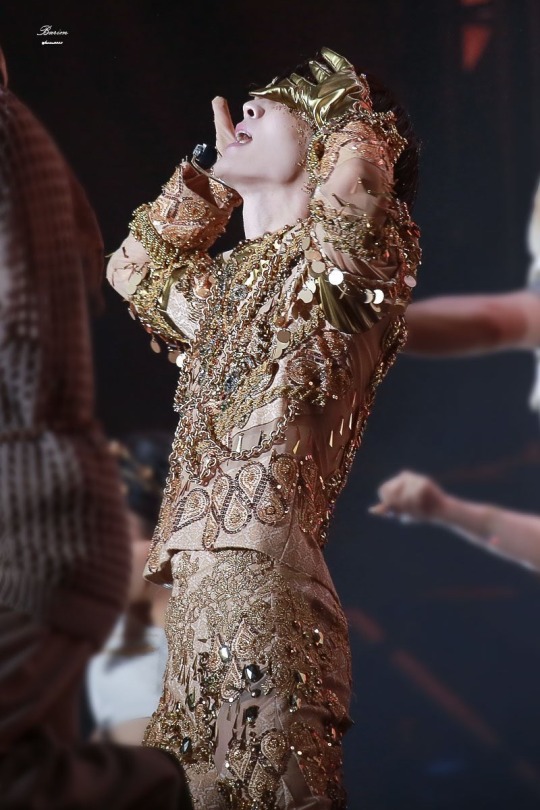
First, I’ll do an overview of the garments themselves, and then I’ll move on to the ornamentation.
The top (it’s not a jacket, it’s not really a shirt, it’s not a tunic. So I’m going with “top”) has a very boxy torso with exaggerated wide, padded shoulders. They’re completely squared. There are straight sleeves—not too slim, not too bulky. There’s a heavily ornamented oversleeve that reaches down to about his elbows and a “nude” colored full length under sleeve. It also has heavily ornamented cuffs at the bottom the sleeve. It has an exposed zipper up the center back that goes up into a short turtleneck collar. The collar and a portion of the lower neck back region are sheer with some beading and appliqués. There are sheer spirals around his arms and in chevrons on his front and scooping around to his back.

Just LOOK AT that masterpiece
The trousers are closely cut through the waist, hips, and thighs but become a bit wider at the knee. It looks like they were made full length but are always worn bunched up over knee high boots. They close at the center front with a very beautifully set fly zipper and flat trouser hook and bar. It’s so low profile that it wasn’t until I got some 4K images that I was even sure of where they closed. It was like he had been sewn in. I wrote a whole thread about it on Twitter that reads like a mystery novel, though I already spoiled the ending for you. Sorry.

The top is made of what is probably a “nude” (aka specially dyed to his skin tone) base fabric to hold the structure, with the ornamentation stitched over top. The external stabilizing fabric is what appears to be some sort of jacquard, possibly silk.
Jacquard is a type of weave, where the fabric is made of long and short “up and down” stitches of sorts, to make a pattern. Because some of the time it uses longer “stitches” on top, it becomes more vulnerable to the fiber breaking and makes it become kind of “fuzzy” looking. This can be especially true if it’s a natural fiber that usually has less structural integrity than a synthetic one. I initially thought this had started to happen on Key’s rear, but after a very close zoom in, I think that’s just a bit of appliqué edge pulling up. I think maybe one of his mic packs is down there too, but I’m really not an expert in that. I did the research so you don’t have to, folks.
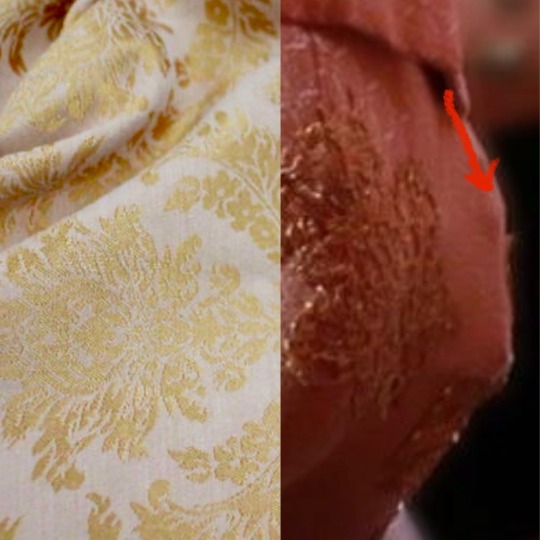
Left: A type of jacquard fabric. The shine comes from the longer top threads, contrasting with details of shorter threads. Right: Is it an applique or is it some snagged fibers? Ultimately, I think it's an applique edge.
Perhaps the most interestingly nerdy thing about jacquard is that it was originally made on a loom that led to the creation of computer programming by utilizing a sort of “binary code.” There were punchcards that showed the strands of fibers when to go up and down. Like “holes and not holes” in which to weave.

A Jacquard Machine Loom with punchcards that create the desired design on the fabric
It’s important to note that this fabric needs to have some stretch because it is also used to make his very tight fitting trousers. If it were not a stretch fabric, he wouldn’t be able to do this like THIS or…most things, really.

Even though the jacquard is stretchy, it has some structure to it. It’s used as a stabilizer in between the “flesh mesh” on the outer layer. (aka power net, stretch mesh... There are many names!) It forms the base on which the majority of the ornamentation is stitched.
Flesh mesh is a stretchy mesh fabric dyed to the performer’s skin color and is used to give the illusion that you’re seeing their skin, but it gives much more strength than just a cutout. I wrote a thread about flesh mesh and the importance of taking into consideration the performer’s actual skin tone when building them a costume here
In this case, flesh mesh allows for adornment of these areas, as well. It’s important to note that, even though it’s a separate layer over the base, it is “tacked” through all layers in a regular fashion so it doesn’t droop with the weight of all of the ornamentation.
There are also some parts that have metallic gold applied pieces. This was probably made of a beefy metallic spandex applied on top of the base rather than some solid pleather, due to way it behaves on the body. The latter would have been way too rigid in comparison to the rest of the fabrics.
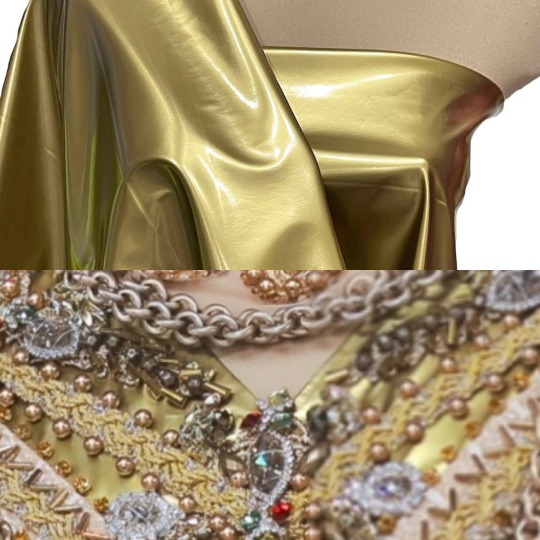
Heavy gold stretch spandex, forming a chevron on which to affix beads and other trims
Okay. Range of movement time. You know how I love discussing this. That’s because it’s the single most important aspect of costumes for dancers.
Let’s talk armpit gussets. They’re an American football shaped piece of fabric that is stitched in the armpit partially to the sleeve underarm, and partially to the torso underarm. It’s often made of a stretch fabric, but sometimes it’s out of the original “fashion fabric,” which is what we call the main garment fabric.

Gussets out of different fabrics under each underarm. You can see the gold bunch under his arm when it's at his side
It allows the performer to more easily move their arms above their chest and head to help keep the top from riding up. You can see in this photo, though, that it does bunch up a little when his arm is down, because of the extra fabric. It has to go somewhere when it’s not taut.
With this particular top, it’s interesting to note that, due to the asymmetrical decoration of his arms, one gusset is the gold stretch fabric and the other is the jacquard. That means that, either both fabrics have the exact same stretch, or his arms may be SLIGHTLY more limited on one side than the other. That’s fun! I really geeked out about this observation.
Often with jackets for dancers, they’ll have what are called “commodity pleats” around the center back shoulder area. They’re a sort of sneaky hidden accordion-like bit of fabric that stretches out during movement that may otherwise split the back open. Taemin uses them a LOT. But, since this top is so boxy, Key doesn’t need them in this instance. He already had the room he needed without any other accommodations.

They put commodity pleats in the back of most of Taemin's closer fitting jackets. I wish they'd make them the same color as his jackets, though!
With Key’s trousers, we’ve already established that they’re made of a fabric with a decent amount of stretch. But since I can’t find many good photos of his bottom half, I’m unsure about if he also has “crotch gussets.”
By this point, I’m kind of notorious as being the “crotch gusset person.”
The following posts explain them in much more detail, but basically, they’re long triangular wedges that start in the trouser crotch and taper down to nothing in the inseam. These are often put in trousers of dancers when people need a better range of movement.
I wrote about this in detail regarding Taemin’s pleather pants he wore in his Metamorph concert, as well as all of SHINee in the Your Number dance video. You can find my posts on the subject here:(Metamorph) (Your Number)

Jinki rocking a black crotch gusset in SHINee's "Your Number" Performance Video (Black Version)
Gussets allow for extra room and movement when one is trying to do extreme leg movements like squatting. Unfortunately, I don’t have many good photos of his inseam. There’s so much going on with appliqués and piecing of mesh vs jacquard, it’s hard to tell. Part of the front half of his trousers is flesh mesh, swirling around them. The other parts are the jacquard, whereas the back is all jacquard.
I saw one photo which made me begin to wonder if the inseam is a little further forward than it could be, though. That could mean there IS a gusset. I’m really not sure...I don't have official visual confirmation, but now you know more about crotch gussets either way. You’re welcome.
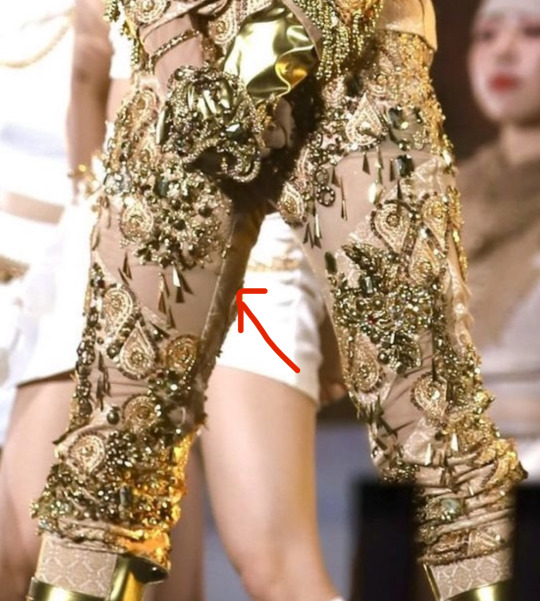
That seam line is up a bit more forward than usual. It really has me wondering, because that would happen if there was a gusset installed. Hmmmm.
Okay. Zipper education time. I apologize in advance. Things get spicy but I tried to tamp it down. The center back (abbreviated as “CB” in the industry) of the top has an exposed zipper. This means exactly what it sounds like: it’s exposed. You look at it, and it looks like there’s a zipper right there. It’s not hidden. Sometimes it’s a perfect match, and sometimes it’s “featured.” Exposed zippers actually become a trend every once in a while in everyday fashion.
I thought it was extremely interesting that, on this elaborate costume, they chose to use a zipper with metallic teeth on white “tape.” (The fabric on the sides of the teeth.) It was a huge disappointment for me, actually. I would have loved to have seen the zipper more carefully hidden like his fly was.

Hello, zipper. I see you loud and clear!
I have to comment a bit on what I view as the one flaw in this otherwise perfect costume. I will preface this by saying that I was not in the fitting room where this was conceived, and I don’t know about any extenuating circumstances and the reasoning behind this decision. But there a few things that I would have done differently regarding the zipper and back collar of this top if were to have made it.
But first: some zipper education. Besides exposed, there are center lapped, as well as regular lapped zippers. With the center lap, it’s like the fabric covers your zipper but you can pull the zipper down through it. Your hoodie probably has one. The regular lap zipper is more like your trouser fly in that there is one flap of fabric that covers the whole zipper, hiding it.

Top: Exposed. (Though it has a matching zipper and zipper tape.) Bottom Left: Center Lapped. Right: Regular Lapped.
Either of those types could have been used to make the zipper more discreet. I personally would have chosen to use a regular lapped zipper, which is less likely to get snagged than a center lapped zipper.
People have defended the exposed zipper by asking if it’s because it’s less likely to get caught. I very much get this argument, and, technically it’s right.
But, in my extensive experience, I don’t think I can recall a case of an exposed zipper in the back of a costume, quick change or no. It’s unattractive. (Not to mention a dead giveaway in a period garment!)
If it’s sewn well and tested, with the correct size lap and no loose fabric, it will work just fine. There should be a hook and eye at the top to make sure that it stays secure while dancing.
Part of being a good dresser is being methodical and purposeful, not frantically zipping something up in a way that is more prone to snagging. They keep their cool, perhaps taking a couple more seconds but ensuring that they pull it up smoothly. They use their fingers to block the overlap as they guide the zipper up.
(Random side note: I met a dresser once who preferred zippers be installed upside down for their quick changes. Hey, whatever works best for them! I wonder how they discovered that…)
I will also note that, as far as I’m aware, the only times he’s worn this costume, he didn’t need to get in or out of it quickly. I know that he wore it in the MV, the Inkigayo performance, and the photoshoot. He also performed at SM Town Tokyo 2022, though he had 11 songs during which to change between Bad Love and this. He never wore this look at his G.O.A.T. in the Keyland concert. Oh, and the collab with the Jinro frog. I’ll talk about that later.
So ultimately, all of the zipper quick change talk is for nothing. There COULD have been a chance that this was going to be worn during his concert, I suppose. But if not, in the end, I can find no reason that there needed to be an exposed zipper other than: they wanted it that way.
Sorry for that rant. I know that it was intense. I just…wish it were pretty. That’s all. I know it wouldn’t have bothered most people, but I personally think that the costume deserved better!
Well then. They arranged the symmetrical beaded appliqué motifs so they didn’t interfere with the center back line, so it wasn’t an issue being all chonky around the zipper.
Unfortunately, since the zipper was built into the neck with just the “stretch mesh,” it moves very differently than the rest of the top. It has a substantially weaker structural makeup and it can’t support itself the same, so it stretched at a different rate than the zipper on the solid fabric on the bottom. It kind of “bubbled” when he moved and it rode up.

Showing the neck bubbling, and, on the bottom left photo, you can see that there is some sheer stabilizer to ensure that the zipper doesn't just tear out of the sheer net.
It couldn’t have been helped unless that whole back neck area had been backed with the solid nude base fabric. That’s what I would have done, personally. But using the stabilizer helped a bit. Without it, it may have not lasted a performance.
I don’t know why they did it that way, but the result was rather disappointing to me, especially considering the care that was taken with the rest of the garment.
Okay. End rant. The rest of the costume is EXQUISITE.
One more thing to note is that the zipper terminates about 4” above the top’s bottom hem. It is right around where his waist is. It was built that way to ensure that he was able to move his legs and hips comfortably without getting hung up anywhere.
His knee high boots were covered with the same peach jacquard as his top, as well as utilizing the gold fabric to serve as ornamental buckled straps.
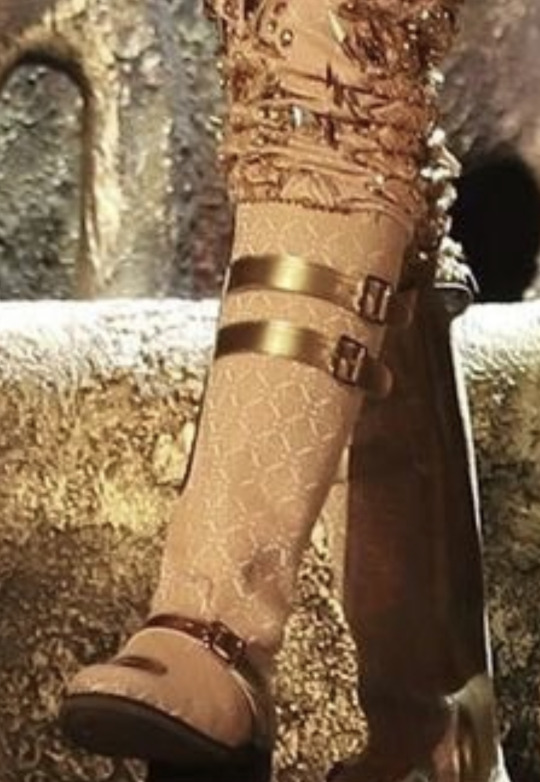
The stretch element of the jacquard is further showcased by the fact that it pulls over the boot toe smoothly, with little issue. A completely stable fabric wouldn’t be able to do that.
Now for the ornamentation. Oooooh boy. There are around twenty types of various adornments on this costume, and I thought I’d highlight some of them.

I can spy about 15 different types of ornamentation here alone.
Beaded appliques at the neckline
Heavy chains
Rhinestone appliques and/or individual rhinestone pieces
Bugle bead chevrons
Gold round beads
Yellow individual small rhinestones
Grey beads in between bugle beads
Gold and silver flat braid trim
Gold stretch fabric
Round flat decorative chain
Hanging paillettes
Dark seed beads with some of the paillettes
Gold dangling lil dudes
A sequined applique peeking out from behind a chain
Utilizing the main fabric as a chevon stabilizer as a design detail
About paillettes: these might actually be my favorites. They’re like “floppy sequins” that only have one hole at an edge. They’re made of a very lightweight plastic, so they’re virtually silent. If you wear a dress completely covered in paillettes, you’ll just hear a little rustle. In this case, his were mainly attached via dangly wires as fringe around the upper sleeves. There are a few other random instances throughout the garment where they’re stitched on individually. You can read more about paillettes in my post here.
Appliqués: There are at least three different types of appliqués in this costume:
Beaded
Lace
Sequined
Rhinestone
Appliqués are premade decorative pieces. It looks like someone hand beaded everything on the costume, but they were able to take a shortcut by using these. So no, contrary to what you might believe, there wasn't someone laboriously hand beading every single thing on to this costume.
It still takes FOREVER to invisibly stitch each motif on to the costume as well as, in this case, sometimes layer upon layer. A lot of them are attached to a net base, and in closeups, I saw how they trimmed the net away closely around the motifs.

On the top, we have the gold paisley sequined appliques. On his trousers, you can see the low profile lurex embroidered lace appliques. Bottom left, you can see the beaded and rhinestone applique. And on the right, beaded appliques. You can see that they're over flesh mesh so, when it's on Key, it just looks like he has a beaded collar.
The sequined, beaded paisley motifs are the most prominent and plentiful form of appliqués, focusing around the top’s cuffs and lower edge. They’re also heavily featured spiraling around the trousers. There are even some appliqués stitched across the seams of the trousers and top.
There are some huge, gorgeous bead and rhinestone appliqués, like this one on his right bicep that you can see in the photo above.
There’s also the Lurex lace (metallic threaded) embroidered appliqués that concentrate mostly on his trousers' waist and hips. It’s low profile without any bits that might snag the top while moving. They added a few jewels to it further down once it was no longer posing any danger to snags. There are also a few flat appliqués on his rear, so as to not make sitting uncomfortable but still be adorned.
Beads and gemstones: There are also individual beads and jewels both sewn and what appears to be discreetly glued on as accents. A popular adhesive we use for that sort of application is called E6000. It bonds pretty much everything from plastic, leather, metal, rubber, and wood. It’s like a slower acting super glue, but is more flexible.
You definitely need to use this in a ventilated area or, ideally, with a respirator. The fumes are no joke! There are little chevrons made out of long tubular metallic bugle beads that were probably glued instead of stitched on. There are also round bronze beads and gold rhinestones glued to the edges of the metallic fabric.
There are little dangling gold dudes, though I don’t know what they’re officially called. There are individual sew on rhinestones. There are circular decorative flat chains. There is gold beaded fringe at the wrists of the sleeves.

Top left: gold braid, beads and chains are heavily featured. Top right: the dangling gold dudes. I don't know what to call them. Bottom left: Paillettes, hanging on gold wires on the upper sleeve hem. Bottom right: Gemstones highlighting the center of the chest, with a whole organized, beautiful mess of braid, beads, etc.
There’s gold flat “braid” trim that also looks like it has a bit of silver in it to add dimension. It’s basically like a braided ribbon, often in metallic colors. It’s used a lot in military uniforms.
And there are a few other various random beads and trims that show up amongst the circus of adornment.
The layout of the overall design is asymmetrical, with left and right arms and legs that don’t match. However, the front of the top is completely symmetrical (which is extremely impressive) except for a few rampant rhinestones that intentionally deviate a bit. Here’s an abomination I made of the sleeves next to each other to see the asymmetry more clearly.

I THINK (not based on this photo but others that aren't Frankensteined together with different perspectives) that the sleeves are actually different lengths as well.
Something that I should cover is that with garments made out of a stretch fabric, like Key’s trousers in this case, stitching on something non-stretchy (like some appliqués) can be fraught. The appliqué can keep the fabric from stretching as much as it needs to accommodate a body in it, and it might tear off.
Sometimes, we need to stretch the fabric a bit as we sew on the motif so it will look normal when a leg is in it. It may look a bit puckered when it’s not being worn. The good news is that it appears that most of the motifs in this costume are on what is most likely a mesh backing, so they probably didn’t have to deal with that headache here!
Since the motif on the Jacquard fabric is pretty small, as well as the fact that some of the appliqués wrapped across the side seams, “pattern matching” wasn’t a big priority on this. However, it’s always preferable to keep the motifs at the same horizontal height. This is a REALLY small pattern, so it wouldn't matter terribly, plus the fact that it was so covered it can hardly be seen. There WAS a point on the right side seam where the pattern did match, but the fabric slightly torqued on the left so it didn’t. All in all, it wasn’t a big deal whatsoever. If it were a bigger print though, it could have been. I made a thread about pattern matching here. It's a subject I'm pretty passionate about!
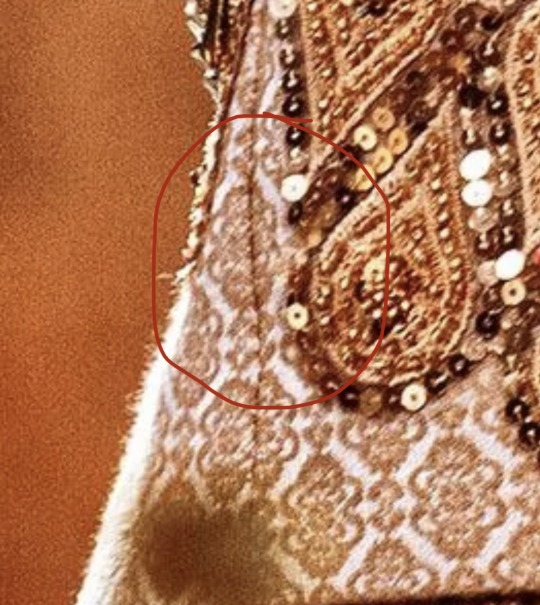
This side seam was cut so that, at a fixed point, the motif was all at the same level horizonatally at there was a part where the motif perfectly matched up to create one complete one. Because there are curves in the seam, it can't do that everywhere.
Now for a bit of a departure: SHINee and its members have done a few collabs over the years, dancing with the frog mascot from Jinro soju. SHINee did one for Don’t Call Me, Taemin did one for Move, and Key did one for Gasoline.
They dressed the frog up like Key, complete with jewels and chains! It was precious. SO GOOD. Watch it now. I also bring this up because that video was the resource I used to figure out where the gold chains on Key’s top were “tacked” (AKA stitched to keep it held down strategically.) It was a nice close-up view. Thanks, Jinro frog!
(Side note: I have made mascots before and it's ironic because they freak me out. I also refurbished a hot dog mascot that had gotten too gross after public appearances over a decade. My life is weird.)

I love how scaled-back but accurate the frog's costume was.
Through the magic of the Jinro frog, I found the answer to the question “where were the chains tacked?” Here. Enough that they still have independent swing and look natural, but frequent enough to keep them from smacking him in the face. Based on the way they move, I think that is metallic coated plastic and not actual metal. Also, for safety's/comfortability's sake! You don't want to be thumped in the chest with every move.
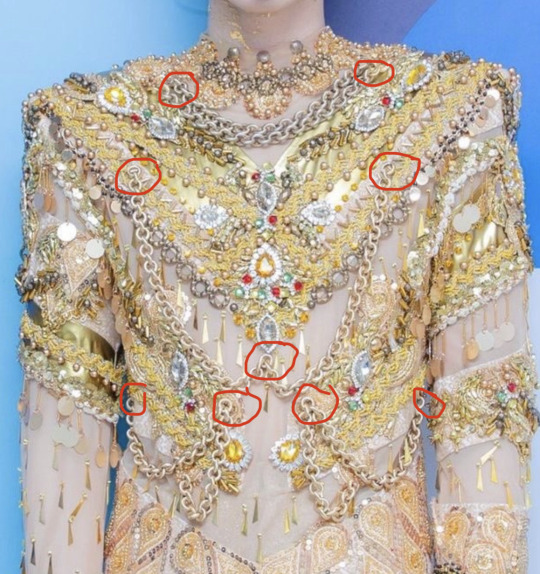
Here's where the chains were tacked
Someone asked me how much they thought this costume weighed. My answer?
I really have no idea…but probably not NEARLY as much as it looks? I'm like 99.9% sure the chains aren't actual metal. I’m not sure if the “jewels” are glass or plastic. The tiiiiiny “seed beads” and "bugle beads" are glass, but there aren’t enough that they would weigh a significant amount. There's a lot of gold braid on there that's very lightweight. A lot of what you see are layered appliqués with sequins and seed beads, which weigh nearly nothing. The dangling paillettes are just a light plastic.
For the garments themselves, as we’ve established, the are a few layers of fabric and mesh, which aren’t very heavy. Because of the “encrusted” nature of the ornamentation, of course, it still weighs a bit more than just a regular top, and is probably kind of rigid on the front. However, it’s not like he’s dancing around in chainmail.
Lastly, there are his gloves. His left one is made out of that heavy gold stretch fabric that was incorporated into the rest of his costume, and his right was also made out of a flesh mesh. From the way it behaves in this photo, it appears to be a much heavier mesh than the top and trousers.
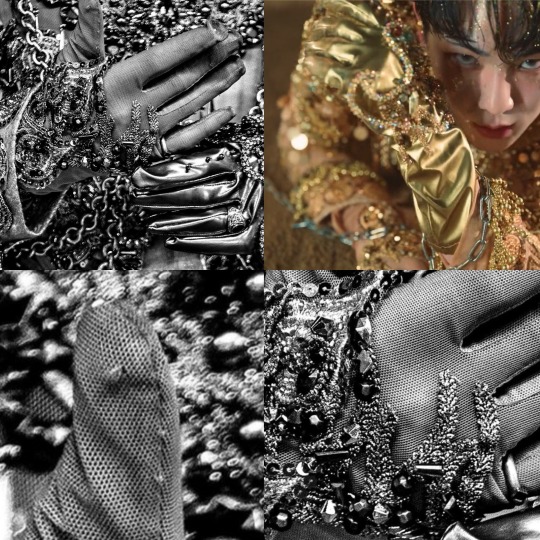
The right glove has thicker mesh that almost appears to have a natural fiber content that is getting snagged. It doesn't completely conform to the skin like a tight flesh mesh would.
The gloves are heavily ornamented with appliqués and beads. I’m going to guess that these were actually custom made for him, which is a big deal. I know very little about glove making, except it involves a TON of pieces to be done right. Gussets in between the fingers to make them slim and elegant and such. No Mickey Mouse hands here.
Stitching the ornamentation on to gloves is pretty difficult work. You either need a hand form and a curved needle or a very brave stitcher who uses their own hand as a form (palm up.) I haven’t done that for gloves, specifically, but I have been a “sacrificial hand” for other situations. I’m so calloused in most places, I don’t really feel much anymore!
There’s one more aspect to this costume that was seen in the intro for his Gasoline Inkigayo performance: the cloak. He didn’t wear it for very long, but it appears to button across his chest to the other shoulder with snaps underneath. The snaps keep the underlap from peeking out from…under the lap.
It looks like they might have had a wardrobe emergency here, because you can see that two of the three snaps were hastily stitched on with red thread. The ornamentation is asymmetrical, mostly focused on his right side. On his left shoulder, there is a decorative beaded “epaulette.” Those are the ornamental shoulder pieces you often see on military dress uniforms.
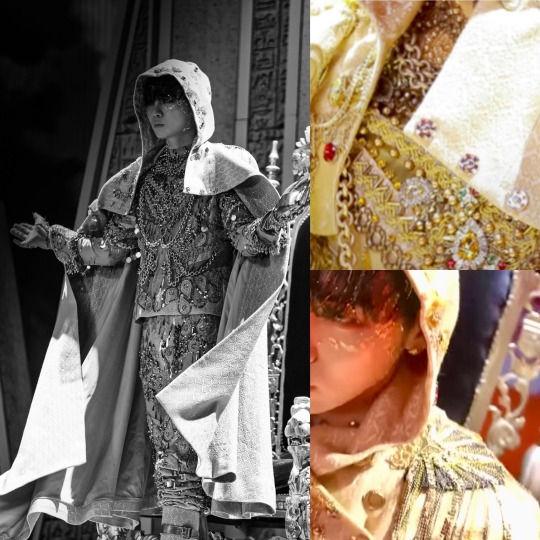
Left: The full cloak. You can see the facing on the inside edges, made of the same fabric as the outside. I'll write about that in a bit, and I'll show you a closer view later. Top right: The red thread holding on the upper snaps. Bottom right: Metallic epaulette.
It’s hooded and made out of the same jacquard fabric as the rest of his costume, and it has a satin lining the same color as the “fashion fabric.” It appears to be about calf length. One of the photos I found actually has a shot that shows the facing, the lining, and how the hem is done. Of course, I nerded out. It’s “self faced,” which means that there’s the same fabric that’s on the outside making up the “facing.” The facing is the first ten inches or so of the inside edge of the cloak. It makes a pretty transition from the outside to the inside, without a harsh switch to lining.
Then, there’s the hem.
While attached at the top, the hem of the lining and the outer fashion fabrics are allowed to “hang out” separately while on a dress form. Because fabrics stretch out at different rates (and it also changes by the direction they’re cut from the fabric, but that’s a whole different lesson…) it’s ideal for something like this to hang on a dress form and do its thing for a day or so.
In an ideal world, you’d have a fitting with your performer and you would mark a “level line” on them while they’re wearing the cloak (and also the shoes they will be wearing. Different shoes can change a lot!)
There are several different ways you can mark a hem. You can safety pin it up the way you want it, using a ruler measuring up from the floor to keep it even. But this can be awkward and clunky.
Or you can safety pin a “level line” and say that it’s, for instance, 18” off the ground, and you’d like the hem to be 16” off the ground. You’d draw a new hemline 2” down from the pins. It's the easiest way to know what's level and then decide exactly what you want to do later.
OR you can use what I call “the poofer” which is a little measuring stick on a tripod with chalk and a rubber squeezy ball that poofs chalk into a line at a set height, instead of dealing with pins. But sometimes the chalk doesn’t like to brush away, so that’s a bit of a risk in exchange for convenience.
First, let’s talk about hemming the outside cloak fabric. Because it may have stretched out unevenly, you may have wildly different hems lengths now that they’ve been “leveled.” Let’s say we’ll leave 6” of “hem allowance” to fold up into the garment so it can be lengthened later if we need to. You’ll trim the rest of it away. I can’t tell you how many times I’ve altered hem lengths on cloaks over the years! I'm always grateful to have extra.
You may want to finish the hem with a “serger” or “overlock” machine, which is the sewing machine that uses 3-4 threads to sew things, often stretch, together and kind of seals off the edges. It’s probably what stitches together the side seams of your t-shirt or hoodie or lounge pants or basically anything stretchy. It’s used to keep hems and the edges of fabrics inside garments from fraying. Sometimes people don’t do it, especially since it's inside, but it’s nice if you’re planning on altering it or if the fabric is really prone to fraying.
The cloak fabric is then thoroughly pinned and hand stitched up. There are many different sneaky stitches which grab a few threads at a time from the front of the fabric and are virtually invisible. Everyone has their favorites. My personal favorite is the “vertical hemming stitch” or “vertical blind hem.” I like it because it holds the inner hem and the outside of the cloak more tightly together than a lot of other styles. The “cross stitch” which is called the “blind catch stitch” here in this diagram is one of the most popular methods. However, I feel it can be a bit too loose some times and is more likely to be caught on something. The one downside of the vertical blind hem is that, if you pull it too tight, it’s more likely to show from the outside. It takes a very sensitive hand to get it right. The lining is usually slip-stitched to the cloak hem.

Once you’ve got your level line of your fashion fabric, it goes back on the dress form. I’m…not entirely sure I’ll do a good job explaining this because I work best with showing things with points and grunts. My apologies.
You mark the lining to match the level where the hem of the fashion fabric ends. You decide how far up from the bottom of the hem you want the lining to end (in this case, 4”.) So normally, you think you'd fold it up 4", right? Ha! You subtract two inches from that number. This means you’ll be folding up only two inches of lining. But, since we will be stitching it 4” up from the hem, that means there’s a floppy extra two inches. (Cue Advice.) What’s that for? Now I have to tell you about “jumps.”
Jumps are a sneaky trick. This method is used in suit coat hems and sleeve linings as well. Basically, they’re a way to give a little bit of wiggle room with the length of the lining to hem interaction.
After the fashion fabric is hemmed, you hand stitch the lining 4” up from the hem. You have two extra inches of lining. One extra inch of lining is pressed down so there’s an extra inch of “underlap". This photo (top right) showed me that they had done this to Key’s cloak. You can see it stretched out with the pressed line on the left, and it is folded over on the right.

Left: The "self fabric facing" at the center front inside of the cloak. Top right: The cloak hem showing the underside of the "jump" (left) and it down in its "resting" position (right). Bottom right: the "poofer." They're marking a level line.
If you want to get even MORE granular, that is considered a “soft press”, which means that the iron steams and very lightly rests on the fabric. A “hard press” is what it sounds like. Squish that lil dude and steam the heck out of it. That line is never gonna come out.
Okay. Enough of that. I can’t believe myself.
I could literally discuss this costume inch by inch, but I think I’ve covered it enough that you can peruse it yourself if you’d like and kind of know what you’re looking at.
I deeply admire and respect the, perhaps, 100+ hours of craftspersonship that it took to make this stunning costume. Don’t even ask me what it cost to make!
Do check out the Instagram of @denicheur.official where you can see other costumes they’ve worked on for groups like IVE, Enhypen, Stray Kids and more. They’ve got an amazing portfolio to drool over.
I hope you’ve gained an even greater appreciation for this gorgeous look, and the knowledge you’ve gained here can go forward with you as you enjoy future costumes! And thanks so much for sticking with me. I hope it was worth it!
#Shinee key#Key shinee#kpop#kpop costume#kpop costumes#Key#shinee#costume design#costume construction#costumes#gold costume#costume analysis#fashion analysis
50 notes
·
View notes
Text
Sen. John Fetterman could land himself in trouble with voters after he doubled down on his claims that he is not a progressive Democrat, despite comments he made during his election campaign.
"I'm not a progressive, I'm just a regular Democrat," Fetterman said on X, formerly Twitter.
The statement was contradicted by the website's community notes feature, referencing tweets from Fetterman in 2016 and 2020 in which he clearly said he was a progressive.
Despite the contradiction, Fetterman has noticeably shifted away from the position upon which he narrowly defeated Donald Trump-endorsed Dr. Mehmet Oz in the 2022 midterms.
Politicians such as Vermont Sen. Bernie Sanders, an independent closely aligned with the left of the Democratic Party, have called for a ceasefire in Gaza, whereas Fetterman has said he supports the Israeli response to the attack by the Palestinian militant group Hamas on October 7 "unequivocally," despite criticism that it has been too strong.
"I just think I'm a Democrat that is very committed to choice and other things. But with Israel, I'm going to be on the right side of that," Fetterman said.
The Pennsylvania senator's stance on Israel is a particular source of ire for many who consider themselves part of the progressive movement, largely younger voters.
A November 2021 poll by Pew Research recorded that 71 percent of the progressive left movement is made up of people aged 18 to 49.
It is young voters that favored Fetterman in his 2022 Senate race against Oz. According to an exit poll taken by Statista, 72 percent of voters aged 18-24 who answered said they voted for the Democrat. The figure was similar for voters aged 25 to 29, at 68 percent.
His position on Israel-Gaza could spell trouble among this voter demographic. According to a New York Times/Siena poll published on Tuesday, 45 percent of people aged 18 to 29 think President Joe Biden is "too supportive" of Israel. In the same age group, 46 percent of people who responded said they were supportive of Palestine, compared to 27 percent favoring Israel.
The same poll said that just 20 percent of all voters aged 18 to 29 believe Biden is handling the conflict well. Asked about the result on CNN on Tuesday, Fetterman said: "If you're getting your perspective on the world on TikTok, it's going to tend to be kinda warped."
He added: "Sometimes you may alienate some voters, but it is really most important to be on the right side on that. That's where I am at."
A total of 16 of his former campaign staffers wrote him an open letter, asking him to change his stance.
"It is not too late to change your stance and stand on the righteous side of history," it said.
An op-ed in news outlet PennLive was published in November by Mireille Rebeiz, Ph.D., chair of Middle East Studies and associate professor at Dickinson College in Carlisle, Pennsylvania, in which his position on the issue was labeled "disturbing" and saying he was "unworthy of my trust."
Fetterman has called for humanitarian aid to be sent to Gaza, but criticized pro-Palestinian protesters when they staged a demonstration outside a Jewish-owned store in Philadelphia in December, calling the gathering antisemitic.
Immigration is also a divisive issue in Congress, and Fetterman has made it clear he wants to work with Senate Republicans and says it is a "reasonable conversation" to have. The GOP has pushed for stricter measures along the southern border with Mexico.
"It's a reasonable conversation—until somebody can say there's an explanation on what we can do when 270,000 people are being encountered on the border, not including the ones, of course, that we don't know about," Fetterman said to NBC. "To put that in reference, that is essentially the size of Pittsburgh, the second-largest city in Pennsylvania."
His wife, Gisele Fetterman, arrived undocumented from Brazil as a 7-year-old and was an important part of his Senate campaign. Some accused him of throwing his wife under the bus because of his stance.
Newsweek has reached out to Fetterman via email through his Senate office for comment.
"Fetterman has never been progressive, but endorsing talks for tougher immigration laws when he's married to an incredible woman who was once an illegal immigrant and who kept his campaign alive while he was recovering from a stroke is actually sickening," said Alexandra Hunt, a former Democrat candidate for Pennsylvania's 3rd Congressional District.
The conversation around Fetterman has some such as left-leaning commentator Mehdi Hasan questioning if he is the "new Kyrsten Sinema," the Arizona senator who became an independent in 2022.
"Fetterman has been a pleasant surprise for his Republican colleagues and a thorn in the side of progressive Democrat," Hasan wrote in British news magazine The Spectator in December. He added: "One still has to wonder if he might follow in Sinema's footsteps and officially extricate himself from the two-party system."
Sinema cited a "deeply broken two-party system" as the reason she left the Democratic Party in 2022.
However, Heath Mayo, a conservative who founded the anti-Trump nonprofit Principles First, praised Fetterman.
"John Fetterman is testing a lot of new boundaries for the Democratic Party right now. Aggressively pro-Israel, pro-border security, anti-corruption in his own party[...]That's principled leadership and Dems should embrace it. He is speaking to a lot of us," Mayo said.
On X, Hasan said Fetterman's comments on him not being aligned with the progressive movement was "a total attack on the people who worked hard to elect him."
23 notes
·
View notes
Text
Solving the Moderator's Trilemma with Federation

The classic trilemma goes: “Fast, cheap or good, pick any two.” The Moderator’s Trilemma goes, “Large, diverse userbase; centralized platforms; don’t anger users — pick any two.” The Moderator’s Trilemma is introduced in “Moderating the Fediverse: Content Moderation on Distributed Social Media,” a superb paper from Alan Rozenshtein of U of Minnesota Law, forthcoming in the journal Free Speech Law, available as a prepub on SSRN:
https://papers.ssrn.com/sol3/papers.cfm?abstract_id=4213674#maincontent
If you’d like an essay-formatted version of this post to read or share, here’s a link to it on pluralistic.net, my surveillance-free, ad-free, tracker-free blog:
https://pluralistic.net/2023/03/04/pick-all-three/#agonism
Rozenshtein proposes a solution (of sorts) to the Moderator’s Trilemma: federation. De-siloing social media, breaking it out of centralized walled gardens and recomposing it as a bunch of small servers run by a diversity of operators with a diversity of content moderation approaches. The Fediverse, in other words.
In Albert Hirschman’s classic treatise Exit, Voice, and Loyalty, stakeholders in an institution who are dissatisfied with its direction have two choices: voice (arguing for changes) or exit (going elsewhere). Rozenshtein argues that Fediverse users (especially users of Mastodon, the most popular part of the Fediverse) have more voice and more “freedom of exit”:
https://en.wikipedia.org/wiki/Exit,_Voice,_and_Loyalty
Large platforms — think Twitter, Facebook, etc — are very unresponsive to users. Most famously, Facebook polled its users on whether they wanted to be spied on. Faced with overwhelming opposition to commercial surveillance, Facebook ignored the poll result and cranked the surveillance dial up to a million:
https://www.nbcnews.com/tech/tech-news/facebook-ignores-minimal-user-vote-adopts-new-privacy-policy-flna1c7559683
A decade later, Musk performed the same stunt, asking users whether they wanted him to fuck all the way off from the company, then ignored the vox populi, which, in this instance, was not vox Dei:
https://apnews.com/article/elon-musk-twitter-inc-technology-business-8dac8ae023444ef9c37ca1d8fe1c14df
Facebook, Twitter and other walled gardens are designed to be sticky-traps, relying on high switching costs to keep users locked within their garden walls which are really prison walls. Internal memos from the companies reveal that this strategy is deliberate, designed to keep users from defecting even as the service degrades:
https://www.eff.org/deeplinks/2021/08/facebooks-secret-war-switching-costs
By contrast, the Fediverse is designed for ease of exit. With one click, users can export the list of the accounts they follow, block and mute, as well as the accounts that follow them. With one more click, users can import that data into any other Fediverse server and be back up and running with almost no cost or hassle:
https://pluralistic.net/2022/12/23/semipermeable-membranes/
Last month, “Nathan,” the volunteer operator of mastodon.lol, announced that he was pulling the plug on the server because he was sick of his users’ arguments about the new Harry Potter game. Many commentators pointed to this as a mark against federated social media, “You can’t rely on random, thin-skinned volunteer sysops for your online social life!”
https://mastodon.lol/@nathan/109836633022272265
But the mastodon.lol saga demonstrates the strength of federated social media, not its weakness. After all, 450 million Twitter users are also at the mercy of a thin-skinned sysop — but when he enshittifies his platform, they can’t just export their data and re-establish their social lives elsewhere in two clicks:
Mastodon.lol shows us how, if you don’t like your host’s content moderation policies, you can exercise voice — even to the extent of making him so upset that he shuts off his server — and where voice fails, exit steps in to fill the gap, providing a soft landing for users who find the moderation policies untenable:
https://doctorow.medium.com/twiddler-1b5c9690cce6
Traditionally, centralization has been posed as beneficial to content moderation. As Rozenshtein writes, a company that can “enclose” its users and lock them in has an incentive to invest in better user experience, while companies whose users can easily migrate to rivals are less invested in those users.
And centralized platforms are more nimble. The operators of centralized systems can add hundreds of knobs and sliders to their back end and twiddle them at will. They act unilaterally, without having to convince other members of a federation to back their changes.
Centralized platforms claim that their most powerful benefit to users is extensive content moderation. As Tarleton Gillespie writes, “Moderation is central to what platforms do, not peripheral… [it] is, in many ways, the commodity that platforms offer”:
https://yalebooks.yale.edu/book/9780300261431/custodians-of-the-internet/
Centralized systems claim that their enclosure keeps users safe — from bad code and bad people. Though Rozenshtein doesn’t say so, it’s important to note that this claim is wildly oversold. Platforms routinely fail at preventing abuse:
https://www.nbcnews.com/nbc-out/out-news/sexual-assault-harassment-bullying-trans-students-say-targeted-school-rcna7803
And they also fail at blocking malicious code:
https://www.scmagazine.com/news/threats/apple-bugs-ios-macos_new_class
But even where platforms do act to “keep users safe,” they fail, thanks to the Moderator’s Trilemma. Setting speech standards for millions or even billions of users is an impossible task. Some users will always feel like speech is being underblocked — while others will feel it’s overblocked (and both will be right!):
https://www.eff.org/deeplinks/2021/07/right-or-left-you-should-be-worried-about-big-tech-censorship
And platforms play very fast and loose with their definition of “malicious code” — as when Apple blocked OG App, an Instagram ad-blocker that gave you a simple feed consisting of just the posts from the people you followed:
https://pluralistic.net/2023/02/05/battery-vampire/#drained
To resolve the Moderator’s Trilemma, we need to embrace subsidiarity: “decisions should be made at the lowest organizational level capable of making such decisions.”
https://pluralistic.net/2023/02/07/full-stack-luddites/#subsidiarity
For Rozenshtein, “content-moderation subsidiarity devolves decisions to the individual instances that make up the overall network.” The fact that users can leave a server and set up somewhere else means that when a user gets pissed off enough about a moderation policy, they don’t have to choose between leaving social media or tolerating the policy — they can simply choose another server that’s part of the same federation.
Rozenshtein asks whether Reddit is an example of this, because moderators of individual subreddits are given broad latitude to set their own policies and anyone can fork a subreddit into a competing community with different moderation norms. But Reddit’s devolution is a matter of policy, not architecture — subreddits exist at the sufferance of Reddit’s owners (and Reddit is poised to go public, meaning those owners will include activist investors and large institutions that might not care about your little community). You might be happy about Reddit banning /r_TheDonald, but if they can ban that subreddit, they can ban any subreddit. Policy works well, but fails badly.
By moving subsidiarity into technical architecture, rather than human policy, the fediverse can move from antagonism (the “zero-sum destructiveness” that dominates current online debate) to agonism, where your opponent isn’t an enemy — they are a “political adversary”:
https://www.yalelawjournal.org/article/the-administrative-agon
Here, Rozenshtein cites Aymeric Mansoux and Roel Roscam Abbing’s “Seven Theses On The Fediverse And The Becoming Of Floss”:
https://test.roelof.info/seven-theses.html
For this to happen, different ideologies must be allowed to materialize via different channels and platforms. An important prerequisite is that the goal of political consensus must be abandoned and replaced with conflictual consensus…
So your chosen Mastodon server “may have rules that are far more restrictive than those of the major social media platforms.” But the whole Fediverse “is substantially more speech protective than are any of the major social media platforms, since no user or content can be permanently banned from the network and anyone is free to start an instance that communicates both with the major Mastodon instances and the peripheral, shunned instances.”
A good case-study here is Gab, a Fediverse server by and for far-right cranks, conspiratorialists and white nationalists. Most Fediverse servers have defederated (that is, blocked) Gab, but Gab is still there, and Gab has actually defederated from many of the remaining servers, leaving its users to speak freely — but only to people who want to hear what they have to say.
This is true meaning of “freedom of speech isn’t freedom of reach.” Willing listeners aren’t blocked from willing speakers — but you don’t have the right to be heard by people who don’t want to talk to you:
https://pluralistic.net/2022/12/10/e2e/#the-censors-pen
Fediverse servers are (thus far) nonprofits or hobbyist sites, and don’t have the same incentives to drive “engagement” to maximize the opportunties to show advertisements. Fediverse applications are frequently designed to be antiviral — that is, to prevent spectacular spreads of information across the system.
It’s possible — likely, even — that future Fediverse servers will be operated by commercial operators seeking to maximize attention in order to maximize revenue — but the users of these servers will still have the freedom of exit that they enjoy on today’s Jeffersonian volunteer-run servers — and so commercial servers will have to either curb their worst impulses or lose their users to better systems.
I’ll note here that this is a progressive story of the benefits of competition — not the capitalist’s fetishization of competition for its own sake, but rather, competition as a means of disciplining capital. It can be readily complemented by discipline through regulation — for example, extending today’s burgeoning crop of data-protection laws to require servers to furnish users with exports of their follow/follower data so they can go elsewhere.
There’s another dimension to decentralized content moderation that exit and voice don’t address — moderating “harmful” content. Some kinds of harm can be mitigated through exit — if a server tolerates hate speech or harassment, you can go elsewhere, preferably somewhere that blocks your previous server.
But there are other kinds of speech that must not exist — either because they are illegal or because they enact harms that can’t be mitigated by going elsewhere (or both). The most spectacular version of this is Child Sex Abuse Material (CSAM), a modern term-of-art to replace the more familiar “child porn.”
Rozenshtein says there are “reasons for optimism” when it comes to the Fediverse’s ability to police this content, though as he unpacked this idea, I found it much weaker than his other material. Rozenshtein proposes that Fediverse hosts could avail themselves of PhotoDNA, Microsoft’s automated scanning tool, to block and purge themselves of CSAM, while noting that this is “hardly foolproof.”
If automated scanning fails, Rozenshtein allows that this could cause “greater consolidation” of Mastodon servers to create the economies of scale to pay for more active, human moderation, which he compares to the consolidation of email that arose as a result of the spam-wars. But the spam-wars have been catastrophic for email as a federated system and produced all kinds of opportunities for mischief by the big players:
https://doctorow.medium.com/dead-letters-73924aa19f9d
Rozenshtein: “There is a tradeoff between a vibrant and diverse communication system and the degree of centralized control that would be necessary to ensure 100% filtering of content. The question, as yet unknown, is how stark that tradeoff is.”
The situation is much simpler when it comes to servers hosted by moderators who are complicit in illegal conduct: “the Fediverse may live in the cloud, its servers, moderators, and users are physically located in nations whose governments are more than capable of enforcing local law.” That is, people who operate “rogue” servers dedicated to facilitating assassination, CSAM, or what-have-you will be arrested, and their servers will be seized.
Fair enough! But of course, this butts up against one of the Fediverse’s shortcomings: it isn’t particularly useful for promoting illegal speech that should be legal, like the communications of sex workers who were purged from the internet en masse following the passage of SESTA/FOSTA. When sex workers tried to establish a new home in the fediverse on a server called Switter, it was effectively crushed.
This simply reinforces the idea that code is no substitute for law, and while code can interpret bad law as damage and route around it, it can only do so for a short while. The best use of speech-enabling code isn’t to avoid the unjust suppression of speech — it’s to organize resistance to that injustice, including, if necessary, the replacement of the governments that enacted it:
https://onezero.medium.com/rubber-hoses-fd685385dcd4
Rozenshtein briefly addresses the question of “filter bubbles,” and notes that there is compelling research that filter bubbles don’t really exist, or at least, aren’t as important to our political lives as once thought:
https://sciendo.com/article/10.2478/nor-2021-0002
Rozenshtein closes by addressing the role policy can play in encouraging the Fediverse. First, he proposes that governments could host their own servers and use them for official communications, as the EU Commission did following Musk’s Twitter takeover:
https://social.network.europa.eu
He endorses interoperability mandates which would required dominant platforms to connect to the fediverse (facilitating their users’ departure), like the ones in the EU’s DSA and DMA, and proposed in US legislation like the ACCESS Act:
https://www.eff.org/deeplinks/2022/04/eu-digital-markets-acts-interoperability-rule-addresses-important-need-raises
To get a sense of how that would work, check out “Interoperable Facebook,” a video and essay I put together with EFF to act as a kind of “design fiction,” in the form of a user manual for a federated, interoperable Facebook:
https://www.eff.org/interoperablefacebook
He points out that this kind of mandatory interop is a preferable alternative to the unconstitutional (and unworkable!) speech bans proposed by Florida and Texas, which limit the ability of platforms to moderate speech. Indeed, this is an either-or proposition — under the terms proposed by Florida and Texas, the Fediverse couldn’t operate.
This is likewise true of proposals to eliminate Section 230, the law that immunizes platforms from federal liability for most criminal speech acts committed by their users. While this law is incorrectly smeared as a gift to Big Tech, it is most needed by small services that can’t possibly afford to monitor everything their users say:
https://www.techdirt.com/2020/06/23/hello-youve-been-referred-here-because-youre-wrong-about-section-230-communications-decency-act/
One more recommendation from Rozenshtein: treat interop mandates as an alternative (or adjunct) to antitrust enforcement. Competition agencies could weigh interoperability with the Fediverse by big platforms to determine whether to enforce against them, and enforcement orders could include mandates to interoperate with the Fediverse. This is a much faster remedy than break-ups, which Rozenshtein is dubious of because they are “legally risky” and “controversial.”
To this, I’d add that even for people who would welcome break-ups (like me!) they are sloooow. The breakup of AT&T took 69 years. By contrast, interop remedies would give relief to users right now:
https://onezero.medium.com/jam-to-day-46b74d5b1da4
On Tue (Mar 7), I’m doing a remote talk for TU Wien.
On Mar 9, you can catch me in person in Austin at the UT School of Design and Creative Technologies, and remotely at U Manitoba’s Ethics of Emerging Tech Lecture.
On Mar 10, Rebecca Giblin and I kick off the SXSW reading series.
[Image ID: A trilemma Venn diagram, showing three ovoids in a triangular form, which intersect at their tips, but not in the middle. The ovoids are labeled 'Avoid angering users,' 'Diverse userbase,' 'Centralized platforms.' In the center of the ovoids is the Mastodon mascot. The background is composed of dead Twitter birds on their backs with exes for eyes.]
#pluralistic#cda#cda230#section 230#content moderation#federation#intermediary liability#mastodon#fediverse#protocols not platforms#activitypub#moderator's trilemma#agonism#subsidiary
93 notes
·
View notes
Text
By Jess Coleman
When, in December 2021, West Virginia Senator Joe Manchin announced he would vote “no” on President Biden’s signature legislative proposal, the Build Back Better Act, the reaction boiled down to: “Well, what did you expect?” After all, Manchin, despite being a Democrat, is from deep-red West Virginia, and politicians from deep-red states simply cannot vote in favor of major progressive policies championed by the leader of the Democratic Party. That’s just politics, dummy. That Biden and his fellow Democrats even tried was treated in some circles as painfully naïve: Unless Democrats learn that basic lesson and bring centrists into the fold, they’ll never achieve a vibrant, sustainable majority. Or so sayeth the conventional wisdom.
So when Manchin announced last week that he is considering leaving the Democratic Party to become an independent, his rationale was hardly difficult to predict. “The brand has become so bad,” he said, drawing on the oft-repeated talking point that the Democrats have lept too far left. In other words—and in contravention of all logic, given the results of the 2022 midterms—Manchin simply cannot in good conscience remain with a party that, in substance and style, provides no room for leaders seeking to appeal to a moderate, bipartisan electorate.
Don’t be fooled. Manchin’s charade is hardly one of principle. It’s one of total desperation.
There are no secrets about Manchin’s political situation at home. After being reelected in 2018 by just 3%, in a year in which Democrats vastly outperformed expectations nationally, Manchin has an enormous hill to climb with his reelection looming in 2024. But the West Virginia Senator doesn’t seem to have much interest in taking responsibility for the electoral crisis in which he has enmeshed himself. Instead, he’d like us to believe the political forces around him have simply left him no choice: Both sides have drawn too far to the extremes, leaving no political home for the critical mass of centrist West Virginians who sent him to Washington. Hence the need to chart a new path on his own.
The framing echoes a convenient perspective that is adored by the media and political establishment: Elections are not won with base voters, but through a small slice of persuadable, moderate swing voters, perpetually lurking just outside of frame. Democrats, in turn, need to have some Joe Manchins—those politicians who embody the voters who are key to electoral success—lying around to be taken seriously. The failure to keep these soi-disant moderate saviors on hand reveals a fundamental structural deficiency for the party writ large.
But if it’s true that Manchin is such a political genius—uniquely capable of surviving as a Democrat in a deep red state—you would expect that his victory is owed to a broad cross section of voters from a variety of political camps. Alas, that’s the complete opposite of what happened in 2018. According to CNN exit polls, Manchin garnered the votes of 64% of those who identify as moderates, and just 23% of conservatives. Those numbers are roughly in line with what New York Senator Kirsten Gillibrand achieved that same year: 70% and 18%, respectively. The reality is Manchin barely made it over the finish line in roughly the same way Democrats all around the country win their seats: by running up the numbers with voters on the political left—Manchin won 80% of self-identified liberals in 2018.
Indeed, as The New Republic’s Alex Pareene observed in 2021, Manchin is actually far more reliant on Democratic voters than many of his blue state counterparts. While someone like Gillibrand can afford to lose large swaths of Democrats in a state where they are in ample supply, Manchin needs to pull virtually every registered Democrat in his state to win. Against all logic, Manchin approached Biden’s first term as if the rules that governed his electoral hopes were precisely opposite to reality. Instead of rewarding his most loyal voters—dyed-in-the-wool liberal Democrats—by delivering for them in Washington, Manchin has spent his latest term going out of his way to alienate his base and position himself in a political no man’s land: personally steamrolling key Democratic priorities while siding with his party on most routine issues and appointments.
In short, Manchin made a bet. He believed he could rely on the support of Democrats and spent nearly all his time trying to appeal to a tiny, if not nonexistent, group of voters who are up for grabs and have no real allegiance to either of the two dominant political parties. It hasn’t worked out the way Manchin anticipated, and this is where he now finds himself—orchestrating a last-ditch, hopeless effort to create a new political reality from thin air.
It is possible Manchin never had a shot at reelection, had fortune and circumstance not permitted him to avail himself of 2018’s political trends, we’d already have a Republican holding that West Virginia Senate seat. But the broader lesson is crucial for those in the media and elected leadership who constantly insist that disregarding the Democratic base in service of pursuing the allegedly vast rewards that come from focusing solely on the views of the so-called centrist, swing voters is the only viable path to victory in American politics. Those who subscribe to this view should explain why the two most notable Democrats who aggressively pursued this approach—Kyrsten Sinema and Joe Manchin—are currently fighting for their political lives, while other red-state Democratic senators such as Sherrod Brown of Ohio and Jon Tester of Montana have consistently survived—and remain loyal to the party’s big priorities even when their electoral hopes face massive headwinds.
Mostly, we have to understand something simple about Manchin: We are not watching a political genius at work. He’s not on the verge of revealing a masterful plan to pull off another miracle in West Virginia. This is a desperate politician squirming for his political life after making a series of catastrophic political decisions. Manchin has hardly proven that the Democratic Party is mortally wounded due to its failure to leave room for the center left. All he’s done is reinforce a very basic rule in politics: Doing the opposite of what your voters want is an idiotic election strategy.
#us politics#news#the new republic#2023#west virginia#sen. joe manchin#biden administration#president joe biden#Democratic Party#Democrats#centrists#independents#2024 elections#sen. Kirsten Gillibrand#Alex Pareene#Sen. sherrod Brown#sen. Jon Tester#Jess Coleman#op eds
19 notes
·
View notes
Text
Poland’s populist ruling party appeared to be on the brink of losing power, after an exit poll in a bitter and high-stakes national election predicted that the country’s opposition has the clearest path to forming its next government.
The poll projected that the Law and Justice party, known by its Polish acronym PiS, would win the most seats after Sunday’s vote.
But it would fall some way short of a parliamentary majority, and the opposition bloc – led by former Polish prime minister and European Council president Donald Tusk – appeared on course to gain control if it struck deals with smaller parties.
Both Tusk and Jaroslaw Kaczynski, the PiS chairman and Poland’s de facto leader, attempted to declare victory on Sunday night. In reality, however, days of negotiations may lie ahead until the make-up of the country’s new government becomes clear.
“The exit poll results give us the fourth victory in the history of our party in the parliamentary elections and the third victory in a row; this is a great success of our formation and our project for Poland,” Kaczynski told supporters.
But in an admission of the tall order facing his party, he added: “We still face the question of whether this success will be able to be transformed into another term of office of our government. And we don’t know that yet. But we must have hope and we must also know that regardless of whether we are in power or in the opposition, we will implement this project in various ways and we will not allow Poland to be betrayed.”
Tusk appeared buoyant, saying: “This is the end of bad times, this is the end of the rule of PiS.” He said his group’s supporters “have won freedom, we have won our Poland back.”
A smaller coalition called Third Way may end up as kingmakers. The centrist bloc has criticized both major parties, arguing that neither represents Poland’s best path forward. But its leader Szymon Hołownia has long lambasted the performance of PiS, and insisted he would not pursue a pact with the incumbent party.
The outcome of this election could have major ramifications for Poland’s future direction, the balance of power in the European Union and the future of the war in Ukraine.
PiS, which has been mired in bitter spats with the EU during its eight years in power, was seeking a third consecutive electoral success – an unprecedented feat since Poland regained its independence from the Soviet Union.
The party has been accused by the EU and Polish opposition figures of dismantling Poland’s democratic institutions during its time in power. PiS has brought the Polish judiciary, public media and cultural bodies under greater control, and has taken a hard line against abortion access and LGBTQ+ rights.
Tusk, by contrast, has presented himself as a leader who would restore and amplify Poland’s standing in Europe. Warsaw has earned goodwill in the West through its response to the Russia’s full-scale invasion of Ukraine in 2022, and smoothing tensions with Brussels could position Poland as a major player in the EU.
During a bitter campaign, PiS shot back at Tusk’s opposition coalition, claiming the former leader would be subservient to Brussels and Berlin if he returned to power.
PiS has overhauled many of Poland’s institutions during its eight-year rule; the judiciary and public media have been brought under greater control, with state-run television outlets essentially becoming government mouthpieces.
Its critics had likened its agenda to that of Viktor Orban, the authoritarian leader of Hungary. Should the opposition oust the party, Warsaw would be expected to reorientate itself towards the United States and Western Europe in terms of foreign policy and reverse many of the domestic changes made by PiS.
But that could be a complicated mission for a coalition government encompassing various ideological groupings. The left-wing party Lewica may be required to prop up a minority Tusk-led government, along with centrists and center-right lawmakers.
High inflation and the security of Poland’s borders have been front of mind for voters during the campaign. Developments were also watched in Kyiv, after a tense period that saw relations between the two close allies sour.
Poland has been a crucial partner to Ukraine as it fights Russian forces in its east, but Warsaw was intensely critical of Ukraine’s government during a dispute over the imports of Ukrainian grain.
Voters were electing members of both houses of Poland’s parliament, with 231 seats in the Sejm – Warsaw’s lower house – needed for a party to clinch power outright.
7 notes
·
View notes
Text
A little father’s day gift after the results of this poll :)
On a serious note, I’m warning that Wille and their parents don’t get along that well and this is (kinda) featured in here. Also, it’s a little longer than a drabble.
Under the cut:

2022.
Wille Eccleston is leaving this town in seven days. No more, no less.
Neither of her parents know about it yet.
She isn't planning on telling them at all, at least not until the very last day. That scenario is clear in her head. Next week, she will be getting hold of her bags, the rest of her needlework money and then follow to her best friend's house with a simple "By the way, I'm moving", or something close to that. She won’t give them enough time to react or put together any sort of emotional speech about how they will miss her.
It isn't a plan, not exactly, but this is all she has.
The moment her sister, Rebecca, enters her room, Wille is working on the last costume she will ever make for her old school’s theater group.
"Lend me a dress," her sister barely says, competing with the loud noise made by the sewing machine, then Rebecca herself turns it off unprompted. “Mom said I could choose one of your dresses!”
Wille annalyzes her sister's frame for a minute, the girl is even shorter than she was at her age.
"It won't fit you, we both know that. Mom must know it, too."
"Let me have it, Willow!"
She pretends to think about it for a second, "Nah."
Rebecca stamps her foot loudly on the wooden floor and, at that sound, their dad's head appears at the bedroom's door, a confused expression on his face.
"Did I hear an argument?”
It has happened way too many times at this point, especially considering how few years they have been on this Earth together, but Wille already learned that, unless she makes a point of being the first one to say something, Rebecca will have no problem throwing her ‘mean sister’ under their parents’ bus.
"Rebecca never gives my stuff back, she proved it too many times."
His confusion turns into weariness, maybe even impatience, "Can't you just... get it from her room when you plan to use it?"
Wille doesn’t have time to come up with an answer that doesn’t spoil her plans, because she can register the exact moment in which her dad sees the bag by the bedroom's corner.
"Hey, what is this?"
Silence. What is there to say?
"Willow, what is this?"
The truth. Maybe.
"Okay. Fine, you win. I'm moving."
"...What? Does your mom know that? Did I know that? It doesn't seem like something I would forget if you told me."
"I haven't had the opportunity to talk to her yet. I will. Tonight."
"That's not-" he seems to remember the girl right there, watching the scene unfold with wild brown eyes. "Leave, Rebecca."
"But I wanted to-"
"No, you didn't. Go to your room, go."
She exits with a frown, but not another word. After the girl leaves, Wille’s dad gets inside the bedroom and closes the door. He stays standing with his arms crossed, staring at her as if he can’t decide whether she is lying or going insane.
"Where did that idea come from? No, of course. See, I’ve always said that friend of yours and her crazy mom weren’t-"
“Don’t say it,” Wille raises her voice at that and he stops whatever he was going to say, at least. “I talk about moving almost every day, why is it such a surprise to you?”
“We thought you were joking!” her dad mumbles something incomprehensible, then says louder. “You can’t just move.”
"Why?"
Deep down, she knows what is coming. Wille can hear the words even before it’s out there in the world, but, for a moment, she hopes her dad will surprise her and say something different.
"Who will take care of the store?"
In the end, she is right.
It stings a little, even if it shouldn’t anymore. Once again, there is no worry about Wille herself, only that hell of a store. Always the same.
"You and mom will, as you already do. You don't really need me here, dad, I would be a terrible manager."
Just say both of you will miss me. Say that I'm your daughter and you love me and I should stay because of that, instead.
"And if something happens? If Lucas breaks an arm and I have to take him to the hospital or if your mom, God forbid, falls ill? What then? We close it, just like that?"
She stays quiet.
"Willow, honey- We don't just do what we want to! Believe me, I know a thing or two about that. Sometimes we… Well, we have responsibilities and we have to stay. Life chooses for us."
Finally, she turns to him and tries to ignore what is implied in his words. He stayed for the family and now he wants her to stay for the business. It’s supposed to be a never-ending story.
She says, "I'm going anyway."
"Oh my God, you’re so stubborn. Do you even have a plan? Any plan?"
Yes. Her train tickets are already bought, their not-fancy but surely affordable apartment is simply waiting for Wille and her best friend by this point and, if her dad can’t tell by the bag that gave her away in the first place, almost all of her clothes are already packed. Still, she lies to him, "No, but I'll figure it out."
"I really don't get what is w-" he stops mid sentence, then opens the door. "Nevermind. Good luck telling you mom that. Don't leave the dirty work to me."
"I won’t."
"She might… I don't know, she might even talk some sense into you. You're 22, for God's sake, you're too old to be this inconsiderate."
He closes the door loudly and leaves, and Willow doesn't bother screaming after him that she is actually 24.
A week after that, she is the one leaving.
16 notes
·
View notes
Text
Uttarakhand Election 2022 India Today Axis Exit Poll : उत्तराखंड में फिर बनेगी बीजेपी सरकार, जानें कांग्रेस का हाल
Uttarakhand Election 2022 India Today Axis Exit Poll : उत्तराखंड में फिर बनेगी बीजेपी सरकार, जानें कांग्रेस का हाल
Uttarakhand Election 2022 Exit Poll: उत्तराखंड चुनाव 2022 के एग्जिट पोल के नतीजे जारी कर दिए गए हैं। इंडिया टुडे ने एक्सिस माई इंडिया के साथ मिलकर यहां एग्जिट पोल किया है। इस एग्जिट पोल के मुताबिक उत्तराखंड में बीजेपी को दोबारा बहुमत मिल सकता है। जबकि पिछड़ती दिख रही कांग्रेस की उम्मीदों पर पानी फिर सकता है। अलग-अलग एग्जिट पोल के मुताबिक आम आदमी पार्टी की जहां पंजाब में सरकार बनती दिख रही है।…
View On WordPress
#aaj tak exit poll live#aaj tak exit poll UP#ABP#according to India today axix my india BJP majority#bjp#BJP majority in Utttrakhand#BSP Congress#congress advantage#Exit Poll of Uttrakhand Election 2022#Exit Poll Uttrakhand Election 2022#India Today Axis My India Exit Poll#latest exit poll of Uttrakhand election 2022#Uttrakhand Chunav exit poll#Uttrakhand Election 2022 Opinion Poll#Uttrakhand Election Exit Poll#Uttrakhand Exit Poll#Uttrakhand exit poll mei kaun jita#Uttrakhand ka exit poll Aaj Tak#Uttrakhand ka Exit poll ABP Cvoter#Uttrakhand ka exit poll kya Bolta hai#Uttrakhand ka exit poll kya kahta hai
0 notes
Text
The Democrat’s Secret Sauce to Win the Midterm elections
The beginning of May before midterm elections signals the official start of primary season and the kickoff of fall campaigns. Because midterms are usually referendums on a president’s performance, the conventional view now is that Democrats are in deep trouble because Biden’s approval ratings are in the cellar.
But the conventional view doesn’t account for the Trump factor, which gives Democrats a fighting chance of keeping one or both chambers.
According to recent polls, Trump’s popularity continues to sink. He is liked by only 38 percent of Americans and disliked by 46 percent. (12 percent are neutral.) And Trump continues to slide: Among voters 45-64 years old – a group exit polls show Trump won 50% to 49% in 2020 – just 39 percent now view him favorably and 57 percent unfavorably. Among voters older than 65 -- 52 percent of whom voted for him in 2000 to Biden's 47 percent – only 44 percent now see him favorably and more than half (54%) view him unfavorably. Importantly, independents hold him in even lower regard. Just 26 percent view him favorably and 68 percent unfavorably.
Republican lawmakers had hoped and assumed that Trump would fade from the scene by the 2022 midterms, allowing them to engage in full-throttled attacks on Democrats.
But Trump hasn’t faded. In fact, his visibility is growing daily.
******
Btw, if you’d like my daily analyses, commentary, and drawings, please subscribe to my free newsletter: robertreich.substack.com
******
The media is framing the May Republican primaries as all about Trump. The Ohio primary was a giant proxy battle over him, in which Republican candidates outdid each other trying to sound just like Trump -- railing against undocumented immigrants, coastal elites, “socialism,” and “wokeness,” and regurgitating the Big Lie.
Trump’s April 15 endorsement of JD Vance made the difference -- as could his backing of Mehmet Oz in Pennsylvania’s Mary 17 primary and Hershel Walker in Georgia’s May 24 primary. But whether Trump’s bets pay off in wins for these candidates is beside the point. Trump is making these races all about himself —and in so doing, casting the midterms as a referendum on his continuing power and influence.
June’s televised hearings of the House January 6 committee will likely show how Trump and his White House orchestrated the attack on the U.S. Capitol, and rekindle memories of Trump’s threat to withhold military aid to Ukraine unless Ukrainian president Zelensky came up with dirt on Biden.
Here again, the real significance of these hearings won’t be seen in Trump’s approval ratings but in Trump’s heightened visibility in the months before the midterms -- and its almost certain shift in voters’ preferences toward the Democrats.
Also likely in June (according to leaked documents) is a decision by the Supreme Court to uphold Oklahoma’s near ban on abortion and reverse Roe v. Wade – courtesy of Trump’s three Court nominees whom Trump explicitly nominated in order to reverse Roe.
The high court’s decision will green-light other Republican states to enact similar bans, and spur Republicans in Congress to push for national legislation to virtually bar abortions across the country. Republicans believe this would ignite their base, but it’s more likely to ignite a firestorm among the vast majority of Americans who believe abortion should be legal. Score another one for Trump.
There is also the distinct possibility of criminal trials over Trump’s business and electoral frauds (such as his brazen attempt to change the Georgia vote tally). Again, their significance for the midterms is less about whether Trump is found guilty than about their continuing reminders of his lawlessness.
Meanwhile, America will be treated to more Trump rallies, interviews, and barnstorming to convince voters the 2020 election was stolen from him, along with his incessant demands that Republican candidates reiterate his Big Lie.
Somewhere along the line, also before the midterms, Elon Musk will allow Trump back on Twitter. The move would be bad for America, but it would remind voters of how whacky, racist, and dangerously incendiary Trump continues to be.
Oh, and don’t forget the antics of Trump’s many surrogates – Tucker Carlson, Marjorie Taylor Greene, Matt Gaetz, Steven Bannon, Madison Cawthorn, and others – who mimic Trump’s bravado, bigotry, divisiveness, and disdain for the law. All are walking billboards for Trumpism’s heinous impact on American life.
All will push wavering voters toward Democrats in November.
I’m not suggesting Democrats seeking election or reelection should center their campaigns around Trump. To the contrary, Democrats need to show their continuing commitment to average working people. Between now and November, they should provide help with childcare, cut the costs of prescription drugs, and stop oil companies for price gouging, to take but three examples.
If they do this, they can count on Trump to remind Americans of the hatefulness and chaos he unleashed. The combination – Democrats scoring some additional victories for working people, and Trump being Trump – could well reverse conventional wisdom about midterms and keep Dems in control of Congress.
164 notes
·
View notes
Text

Red Wave? More like Red Wedding.
* * * *
Democrats should be proud! :: November 9, 2022
Robert B. Hubbell
It is 9:00 PM Pacific as I begin to write this evening’s newsletter and only a few races have been called. But this much is clear: Democrats have every reason to be proud of their battle in the midterms. Control of Congress still hangs in the balance, but it is unlikely that there will be a “red wave” at the national or state level. Yes, there are disappointments (Beto O’Rourke, Stacey Abrams, Tim Ryan, Val Demings, Cheri Beasley), but there are reasons for celebration—Senator Maggie Hassan defeating election denier Don Buldoc in New Hampshire and Josh Shapiro beating election denier Doug Mastriano in Pennsylvania’s governor’s race. (The latter may be key in protecting the integrity of the 2024 presidential election.) Kathy Hochul became the first woman to be elected as governor of New York, and Becca Balint became the first woman and openly gay person to represent Vermont in Congress.
As recently as a week ago, Republican pollsters were predicting the GOP would pick up 35 seats in the House. That prediction is in line with “conventional wisdom” that the party in power loses seats in Congress. Exit polling by CNN shows that “inflation” was the most important issue to the largest bloc of voters—an issue that (wrongly) favors Republicans. And yet—at midnight Eastern time, the most likely outcome in the House is that the majority party will maintain control by a handful of seats (per MSNBC).
Despite heavy criticism of Democratic messaging, something must account for the fact that Democrats are overperforming as measured against conventional wisdom. That “something” is Democratic messaging about democracy, reproductive liberty, and Joe Biden’s legislative achievements, including infrastructure, climate, social benefit programs, and fighting inflation. Whether those messages are sufficient to hold the House remains to be seen—but they appear to be enough to deny Kevin McCarthy the “mandate” he believed was his divine right.
The Senate likewise seems too close to call, but Mitch McConnell’s early (and now withdrawn) predictions of a GOP majority may come down to a run-off in Georgia between Raphael Warnock and Herschel Walker.
The most positive indicator for the health of our democracy is that 8-in-10 voters believe that elections are conducted in a manner that is fair and accurate. After two years of non-stop election denialism by the GOP, that is good news, indeed. Per CNN,
Roughly 8 in 10 of voters in this year’s midterms said they were at least somewhat confident that elections in their state are being conducted fairly and accurately, according to the preliminary national results of the exit poll conducted for CNN and other news networks by Edison Research.
About half said they were very confident. Only about 2 in 10 said they were not very or not at all confident.
Even where Democrats have suffered defeat, they have fought well and kept races closer than Trump’s margin of victory in 2020. More on that in future newsletters.
As we await the full results, it is worth reflecting on predictions that most definitely did not come true. For a period of two weeks, major media outlets were breathlessly reporting that MAGA vigilantes acting as self-appointed “poll watchers” would show up en masse on Election Day—possibly armed. In October, Steve Bannon was telling anyone who would listen that Republicans would have a 45,000 member “Army of Patriots” intimidating voters at the polls. Except for one drop-box in Maricopa County, Arizona, the armed vigilantes failed to materialize. And if the 45,000 MAGA poll watchers showed up, they did not make their presence known. See USA Today, Voting rights experts report a smooth midterm election, some glitches. (“The relative calm on Tuesday was at odds with the run-up to the election . . . .”)
Of course, even a single armed vigilante intimidating voters is unacceptable. But at the 230,000 polling locations in the U.S., it appears that there were few, if any, incidents of armed intimidation or aggressive behavior by MAGA poll watchers. For that, we should be thankful.
When Bannon and others touted their “45,000” member army of poll watchers, I received panicked emails from readers who assumed that those poll watchers would cause havoc, intimidate voters, and suppress turnout. That didn’t happen, but Bannon’s propaganda had its intended effect: it instilled fear and doubt in Democrats. See Yahoo News / AFP, Right-wing election 'army' sparks fear for US midterms.
We should always take threats of voter intimidation and suppression seriously. But we should also remember that Republicans are attempting to exaggerate their prowess in order to mess with our minds. Republicans don’t have superpowers—except when it comes to deceit, depravity, and shamelessness. Let’s keep that in mind for the next few weeks when, and if, Republicans make grandiose claims of what they plan to do with any victories they achieve in the midterms.
8 notes
·
View notes
Text
by Emily Bloch
Philadelphia Enquirer
Nov 12, 2022
Democrats are thanking Gen Zers for showing up and showing out at the polls.
Numbers are still coming in, but early exit polls show that a surge in young people voting in the midterm election may have boosted overall turnout and contributed to some better-than-expected results for Democrats.
Estimates say that about 27% of people ages 18 to 29 — Zoomers and those on the Gen Z-Millennial cusp — cast ballots this November, according to the Center for Information and Research on Civic Learning and Engagement at Tufts.
In midterm general elections dating back to the 1990s, turnout among the same age group has hovered around 20%.
“I don’t think older generations realize how fundamentally angry we are,” said Maddie Billet, 20, a sophomore at George Washington University and Bucks County native who voted Democratic. “We’re angry with policies and practices that have set up our lives to be a struggle from day one. We were born into a world where the environment is crumbling, democracy is dying, bigotry is becoming the norm, and we’re angry about it.”
No official sources of demographic voter data are immediately available after elections. CIRCLE bases its numbers on exit polls. Figures likeHarvard University’s Cooperative Election Study, Pew surveys, and Census Bureau voting data will only drop in the coming months.
At a press conference Wednesday, President Joe Biden thanked young people for showing up to the polls in “historic numbers.” CIRCLE said its estimates place young voter turnout at its second-highest since the 1990s, below only 2018′s 31%.
And for most Gen Z voters, CIRCLE estimates indicate,their ballots went blue.
Experts say that young people’s tenacity may have been the difference between Republicans’ promised “red wave” and the actual midterm results, which saw Democrats losing fewer U.S.House seats than expected and even flipping Pennsylvania’s Senate seat blue.
CIRCLE reported that young people overwhelmingly backed Democrats for U.S. House and Senate races. Gen Z’s support of Democratic candidates including incumbent Govs. Gretchen Whitmer in Michigan andTony Evers in Wisconsin, and Sen.-elect John Fetterman over Mehmet Oz in Pennsylvania proved to be critical, the data shows.
Read more.
3 notes
·
View notes
Text
This day in history

I’m coming to the HowTheLightGetsIn festival in HAY-ON-WYE with my novel Red Team Blues:
Sun (May 28), 1130h: The AI Enigma
Mon (May 29), 12h: Danger and Desire at the Frontier
I’m at OXFORD’s Blackwell’s on May 29 at 7:30PM with Tim Harford.
Then it’s Nottingham, Manchester, London, Edinburgh, and Berlin!

#15yrsago UK set to deport Master’s student whose Master’s degree research led him to look up Al Qaeda info — ratted out by University of Nottingham https://www.theguardian.com/education/2008/may/24/highereducation.uk
#15yrsago Frequently Awkward Questions for the Canadian Minister who’s planning to bring down a Canadian DMCA https://www.michaelgeist.ca/2008/05/ten-more-questions-for-prentice-post/
#10yrsago Little Mermaid’s Ursula does the Haunted Mansion narration https://www.youtube.com/watch?v=rwoTHwJmyCg
#10yrsago US entertainment industry to Congress: make it legal for us to deploy rootkits, spyware, ransomware and trojans to attack pirates! https://lauren.vortex.com/archive/001034.html
#10yrsago Triple-nested Klein bottle https://web.archive.org/web/20080605031208/https://www.sciencemuseum.org.uk/images/I065/10328078.aspx
#5yrsago Ireland’s referendum results: legalised abortion projected to win “by a landslide” https://www.irishtimes.com/news/politics/irish-times-exit-poll-projects-ireland-has-voted-by-landslide-to-repeal-eighth-amendment-1.3508861
#5yrsago Congressional staffers for Rep. Tom Garrett [R-VA] say they were used as “personal servants” https://www.politico.com/story/2018/05/25/tom-garrett-staff-servants-608665
#1yrago Attacking machine learning training by re-ordering data https://pluralistic.net/2022/05/26/initialization-bias/#beyond-data

Catch me on tour with Red Team Blues in Hay-on-Wye, Oxford, Manchester, Nottingham, London, and Berlin!
2 notes
·
View notes
Text
As Gen Z headed to the polls this week, conservative commentators had a message for young voters: please stop.
Tuesday’s midterm election saw Gen Z come out strong for Democrats, including for their generation’s first U.S. representative: Maxwell Frost, a 25-year-old Democrat from Florida. The young blue bloc left Fox News personalities dismayed, with other conservative voices suggesting that the minimum voting age be raised from 18 (currently enshrined in the Constitution) to 21 or 28.
“The fact that these youth voters are coming in so strong in an off-year is very concerning,” Fox News commentator Jesse Watters lamented on Wednesday night. “It looks like they’ve been brainwashed. This new generation is totally brainwashed ’cause a lot of these single women [who] vote 37 spreads for Democrats, are teaching all of our younger generation in these schools and they’re polluting their minds and then they grow up and they’re in their twenties and then they vote for leftists.”
Exit polling shows strong youth support for Democrats, typically on issues like climate change, reproductive rights, and guns. Voters aged 18-24 (all of whom fall into Gen Z) voted 61% for Democrats, while the 25-29 age group, some of whom are Gen Z, voted 65% blue, exit polls show.
Research by Tufts University’s Center for Information and Research on Civic Learning and Engagement (CIRCLE), suggests 27% of people ages 18-29 voted in the election. It’s the second-highest youth turnout in midterm history, Al Jazeera reported.
Frost, the newly elected representative from Florida, said his generation is fired up over the overturning of Roe v. Wade, and economic issues like student debt.
“We see that young people see the economy through a very specific lens, looking at things like crushing debt, not because we live beyond our means, but because we’ve been denied the means to live,” Frost told The Daily Beast. He pointed to President Joe Biden’s student debt relief program as a win with young voters.
Other Fox stars acknowledged the right’s weakness with young people. “We have to win over voters outside of our traditional base,” Fox News host Laura Ingraham said on her program Wednesday night. “That means young people too.”
Young voters’ support for Democrats actually softened between 2018 and 2022, exit polls suggest. Democratic support among the 18-29-year-old age cohort dropped seven points between the two elections, according to a CNN analysis of exit polls. But virtually all demographics swung right this election, with Democratic backing taking a larger hit in other age groups like 30- to 44-year-olds.
Other conservative voices were less rosy on winning the youth vote. In a now-viral series of tweets, anti-Muslim activist Brigitte Gabriel suggested barring America’s youngest voters from the polls.
“Raise the voting age to 21,” Gabriel tweeted, immediately after noting that “We were promised a red wave and we got a red puddle.”
She went on to tweet that “Generation Z thinks doing drugs in the street should be legal. Generation Z also thinks speech that offends them should be illegal.”
Though Gabriel didn’t specify which drugs, a Gallup poll last year found that 68% of Americans (including 50% of Republicans) support legalizing marijuana. And despite a strong push by Republican legislatures to ban educational material about race and gender issues, Gen Z students overwhelmingly favor strong free speech rights, 2022 polling shows.
Not to be outdone, conservative radio personality Peter Schiff suggested cutting out current Gen Z voters altogether. “Let's raise the voting age to 28. If I was still 18 I'd support this,” the 59-year-old tweeted.
The current 18-year minimum age for voting is guaranteed by the Constitution’s 26th amendment, which passed, in part, because the Vietnam War draft was conscripting people too young to vote.
Frost said he wasn’t shocked to hear talk of disenfranchising young voters. He likened the talk to existing measures that make voting more difficult for people of color.
“When voters don’t vote in their favor, what do they look to do?” he asked. “Change the votes, change the electorate, change the people who can vote. That’s why we see these horrible voter suppression laws championed by the GOP to suppress the votes of Black and brown people, to put it bluntly.”
“I think the GOP's doing the calculation,” Frost added, “‘half these people can’t vote yet. What does this mean for us in the future?’”
#us politics#news#2022#republicans#2022 midterms#2022 elections#voter disenfranchisement#voter suppression#voter demographics#gen z#gop#Maxwell Frost#us constitution#the daily beast#26th amendment#Brigitte Gabriel#Peter Schiff#Laura Ingraham#fox news#tufts university#Center for Information and Research on Civic Learning and Engagement#Jesse Watters#raising the voting age#conservatives#republicans be like#conservatives be like#fascists be like
49 notes
·
View notes